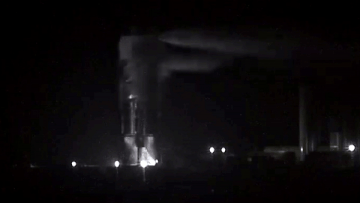SpaceX's Starship SN3 prototype collapses in pressure tank test
Elon Musk says a test configuration mistake may be to blame.
SpaceX began testing its newest prototype of a massive Starship vehicle in Texas overnight, and video footage suggests that process did not go smoothly.
Starship is the company's massive spacecraft designed to colonize Mars and tackle other heavy-lift deep-space missions. For about a year now, SpaceX has been building and testing various prototypes of the vehicle, including a miniature Starhopper that flew in August 2019. The latest version, dubbed SN3 (short for Serial No. 3) was scheduled to undergo a series of tests culminating in short, "hopping" flights. But something went wrong in an early test conducted yesterday (April 2).
"We will see what data review says in the morning, but this may have been a test configuration mistake," SpaceX CEO Elon Musk said in a post on Twitter.
"Some valves leaked at cryo temp. Fixing & will retest soon," Musk added in a follow-up tweet.
Video: Watch SpaceX's Starship SN3 collapse during pressure test
More: SpaceX's Starship and Super Heavy rocket in pictures
Video of the SpaceX's SN3 test captured by Spadre.com and NASASpaceflight.com showed the vehicle's pressure test failure from different angles.
The test, a cryogenic pressure test, was intended to demonstrate that SN3 could withstand the high pressure of very cold fuel that such a vehicle will need to endure before flights. In another tweet, Musk said that SN3 had passed an ambient temperature test the night prior to the failed cryogenic pressure test.
Breaking space news, the latest updates on rocket launches, skywatching events and more!
The cryogenic pressure test would have been followed by a static fire, during which the vehicle's engines would have briefly lit while SN3 was held in place, and a hopping test, when SN3 would have made the first flight of a full-size Starship prototype.
Instead, the video footage taken near SpaceX's Starship hub in Boca Chica, Texas, appears to show SN3 collapse under pressure.
SN3 is the third SpaceX Starship prototype to be lost during testing. The company's first Starship Mk1 was destroyed during a failed pressure test in November 2019. Its successor, the Starship SN1 (or Serial Number 1), was lost in a pressure test in Feb. 28 of this year. A subsequent prototype, called Starship SN2, successfully passed the same pressure test on March 8. Each iteration of Starship has included tweaks and improvements over its predecessor.
The Starship SN3's failed test means that the company will presumably move on to SN4 as it continues to sort out design issues. Musk had previously said he wanted to see that vehicle reach as high as 12 miles (20 kilometers) above Earth's surface.
SpaceX has been pushing hard on Starship development in recent months despite the test failures. The spacecraft (and a planned megabooster called Super Heavy) form the core of SpaceX's plan for deep-space missions to the moon, as well as for Mars colonization.
We will see what data review says in the morning, but this may have been a test configuration mistakeApril 3, 2020
During a recent Falcon 9 rocket launch carrying 60 Starlink internet satellites las month, SpaceX put out a call for welders and other professionals to join the company's push to build new Starships. Musk also held a career day in February at the Boca Chica site to interview new workers.
Earlier this week, SpaceX unveiled a users' guide for Starship describing the different payloads and missions, crewed and uncrewed, it could fly for customers.
SpaceX has already signed one customer for a Starship flight. Japanese billionaire Yusaku Maezawa has booked a trip around the moon on the spacecraft, with a target launch date of 2023.
- SpaceX: Facts about Elon Musk's private spaceflight company
- Welders wanted: SpaceX is hiring to ramp up production of stainless steel Starship
- How living on Mars could challenge colonists (infographic)
Email Meghan Bartels at mbartels@space.com or follow her @meghanbartels. Follow us on Twitter @Spacedotcom and on Facebook.
OFFER: Save at least 56% with our latest magazine deal!
All About Space magazine takes you on an awe-inspiring journey through our solar system and beyond, from the amazing technology and spacecraft that enables humanity to venture into orbit, to the complexities of space science.

Meghan is a senior writer at Space.com and has more than five years' experience as a science journalist based in New York City. She joined Space.com in July 2018, with previous writing published in outlets including Newsweek and Audubon. Meghan earned an MA in science journalism from New York University and a BA in classics from Georgetown University, and in her free time she enjoys reading and visiting museums. Follow her on Twitter at @meghanbartels.


